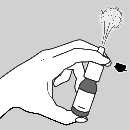
Motesin
Ask a doctor about a prescription for Motesin

How to use Motesin
PATIENT INFORMATION LEAFLET
Leaflet accompanying the packaging: information for the user
Motesin
(137 micrograms + 50 micrograms)/dose
nasal spray, suspension
Azelastine hydrochloride + Fluticasone propionate
Read the leaflet carefully before using the medicine, as it contains important information for the patient.
- Keep this leaflet, you may need to read it again.
- In case of any doubts, consult a doctor or pharmacist.
- This medicine has been prescribed specifically for you. Do not pass it on to others. The medicine may harm another person, even if their symptoms are the same.
- If the patient experiences any side effects, including any side effects not listed in this leaflet, they should tell their doctor or pharmacist. See section 4.
Table of contents of the leaflet
- 1. What is Motesin and what is it used for
- 2. Important information before using Motesin
- 3. How to use Motesin
- 4. Possible side effects
- 5. How to store Motesin
- 6. Package contents and other information
1. What is Motesin and what is it used for
Motesin contains two active substances: azelastine hydrochloride and fluticasone propionate.
- Azelastine hydrochloride belongs to a group of medicines called antihistamines. Antihistamines work by preventing the action of substances such as histamine, which the body produces as part of an allergic reaction, and thereby reducing the symptoms of allergic rhinitis.
- Fluticasone propionate belongs to a group of medicines called corticosteroids, which reduce inflammation.
Motesin is used to relieve the symptoms of moderate to severe seasonal and perennial allergic rhinitis, if the use of other nasal products containing only an antihistamine or corticosteroid is considered insufficient.
2. Important information before using Motesin
When not to use Motesin
- if the patient is allergic to azelastine hydrochloride or fluticasone propionate or any of the other ingredients of this medicine (listed in section 6).
Warnings and precautions
Before starting to use Motesin, discuss with your doctor or pharmacist:
- If the patient has recently undergone nasal surgery.
- If the patient has a nasal infection. Nasal infections should be treated with antibacterial or antifungal medicines. Patients who have been treated with medicines for a nasal infection may continue to treat their allergy with Motesin.
- If the patient has tuberculosis or an untreated infection.
- If the patient notices a change in vision or has been diagnosed with increased intraocular pressure, glaucoma, and/or cataract. Patients with these conditions will be closely monitored during treatment with Motesin.
- If the patient has adrenal gland problems. Caution is advised when switching from systemic steroid therapy to Motesin therapy.
- If the patient has severe liver disease. This increases the risk of systemic side effects.
In these cases, the doctor will decide whether Motesin can be used.
Children and adolescents
Motesin is not recommended for use in children under 12 years of age.
Motesin and other medicines
Tell your doctor or pharmacist about all medicines you are taking, have recently taken, or might take, including those available without a prescription.
Pregnancy and breastfeeding
If you are pregnant or breastfeeding, think you may be pregnant, or plan to become pregnant, consult your doctor or pharmacist before using this medicine.
Driving and using machines
Motesin has a minor influence on the ability to drive and use machines.
Motesin contains benzalkonium chloride
This medicine contains 14 micrograms of benzalkonium chloride in each spray.
3. How to use Motesin
Always use this medicine exactly as your doctor has told you.
Administration in adults and adolescents (12 years and older)
Use one spray into each nostril, morning and evening.
Administration in children under 12 years
Motesin is not recommended for use in children under 12 years of age.
Administration in patients with renal and hepatic impairment
There are no data available on the use of Motesin in patients with renal and hepatic impairment.
Method of administration
Nasal spray.
INSTRUCTIONS FOR USE
Preparing the spray
- 1. Gently shake the bottle for 5 seconds, moving it up and down, then remove the protective cap.
- 2. If the nasal spray is used for the first time, prime the pump by releasing a dose into the air.
- 3. To prime the pump, place two fingers on either side of the pump and your thumb on the bottom of the bottle.
- 4. Press and release the pump 6 times, until a fine spray appears (see figure a).

a
- 5. The pump is now primed and ready for use.
Using the spray
- 1. Gently shake the bottle for 5 seconds, moving it up and down, then remove the protective cap.
- 2. Blow your nose to clear your nostrils.
- 3. Tilt your head forward, towards your toes. Do not tilt your head back.
- 4. Hold the bottle upright and gently place the tip of the spray into one nostril.
- 5. Close the other nostril with your finger, press the pump quickly once, and breathe in gently at the same time (see figure b).

b
- 6. Breathe out through your mouth.
- 7. Repeat the same steps for the other nostril.
- 8. After using the spray, breathe in gently and do not tilt your head back. This will help prevent the medicine from going down the back of your throat and causing an unpleasant taste.
- 9. After each use, wipe the tip of the spray with a clean tissue or cloth and replace the protective cap.
- 10. If the tip of the spray becomes blocked, do not try to unblock it with a sharp object. Rinse the tip with water.
It is essential to use the dose prescribed by your doctor.
Duration of treatment
Motesin can be used for a long time. The duration of treatment should correspond to the period during which allergy symptoms occur.
Using a higher dose of Motesin than recommended
In case of using too much nasal spray, there is a small chance of complications. Consult a doctor if you have any concerns or if you have been using a higher dose than recommended for a long time.
Missing a dose of Motesin
Use the nasal spray as soon as you remember, and then use the next dose at the usual time. Do not use a double dose to make up for a missed dose.
Stopping treatment with Motesin
Do not stop using Motesin without consulting your doctor, due to the risk of treatment failure.
4. Possible side effects
Like all medicines, Motesin can cause side effects, although not everybody gets them.
- Nosebleeds
Common side effects (may affect up to 1 in 10 people):
- Headache
- Bitter taste in the mouth, especially if you tilt your head back during spraying. This taste should disappear if you drink a non-alcoholic beverage a few minutes after using the spray
- Unpleasant odor
Uncommon side effects (may affect up to 1 in 100 people):
- Mild irritation inside the nose. This may cause a mild stinging, itching, or sneezing sensation
- Dryness in the nose, cough, dry throat, or throat irritation
Rare side effects (may affect up to 1 in 1,000 people):
- Dry mouth
Very rare side effects (may affect up to 1 in 10,000 people):
- Dizziness or drowsiness
- Cataract, glaucoma, or increased eye pressure, which may cause loss of vision and/or eye redness and pain. These side effects have been reported after long-term use of nasal sprays containing fluticasone propionate.
- Skin and nasal mucosa damage
- General feeling of being unwell, tiredness, fatigue, or weakness
- Rash, itching, or redness of the skin, itchy blisters on the skin
- Bronchospasm (narrowing of the airways)
Immediately seek medical attention if you experience any of the following symptoms:
- Swelling of the face, lips, tongue, or throat, which may cause difficulty swallowing
and/or breathing, as well as a sudden appearance of a skin rash.These may be symptoms of a severe allergic reaction.
5. How to store Motesin
Keep this medicine out of the sight and reach of children.
Do not use this medicine after the expiry date which is stated on the label and carton after EXP.
Do not store in the refrigerator or freeze.
Shelf life after first opening: Do not use Motesin after 6 months of first opening the nasal spray.
Medicines should not be disposed of via wastewater or household waste. Ask your pharmacist how to dispose of medicines no longer required.
6. Package contents and other information
What Motesin contains
- The active substances are azelastine hydrochloride and fluticasone propionate. Each gram of suspension contains 1000 micrograms of azelastine hydrochloride and 365 micrograms of fluticasone propionate.
After each actuation of the pump (0.14 g), 137 micrograms of azelastine hydrochloride (= 125 micrograms of azelastine) and 50 micrograms of fluticasone propionate are released.
- The other ingredients are disodium edetate, glycerol, microcrystalline cellulose, sodium croscarmellose, polysorbate 80, benzalkonium chloride, phenylethyl alcohol, and purified water.
What Motesin looks like and contents of the pack
Motesin is a white or almost white homogeneous suspension.
Motesin is available in a brown glass bottle with a pump spray, applicator, and protective cap, in a cardboard box.
The 25 mL bottle contains 23 g of nasal spray suspension (at least 120 doses).
Marketing authorisation holder and manufacturer
Marketing authorisation holder
SUBSTIPHARM
24 rue Erlanger
75016 Paris
France
Manufacturer
FARMEA
10, rue Bouché Thomas
ZAC d’Orgemont
49007 Angers
France
This medicinal product is authorised in the Member States of the European Economic Area under the following names:
Poland: Motesin
Sweden: Motesin
Date of last revision of the leaflet:
- Country of registration
- Active substance
- Prescription requiredYes
- ImporterFarmea
- This information is for reference only and does not constitute medical advice. Always consult a licensed doctor before taking any medication. Oladoctor is not responsible for medical decisions based on this content.
- Alternatives to MotesinDosage form: Aerosol, (137 mcg + 50 mcg)/doseActive substance: fluticasone, combinationsPrescription requiredDosage form: Aerosol, (137 mcg + 50 mcg)/ doseActive substance: fluticasone, combinationsPrescription requiredDosage form: Aerosol, (137 mcg + 50 mcg)/nasal doseActive substance: fluticasone, combinationsPrescription required
Alternatives to Motesin in other countries
The best alternatives with the same active ingredient and therapeutic effect.
Alternative to Motesin in Spain
Alternative to Motesin in Ukraine
Online doctors for Motesin
Discuss dosage, side effects, interactions, contraindications, and prescription renewal for Motesin – subject to medical assessment and local rules.








